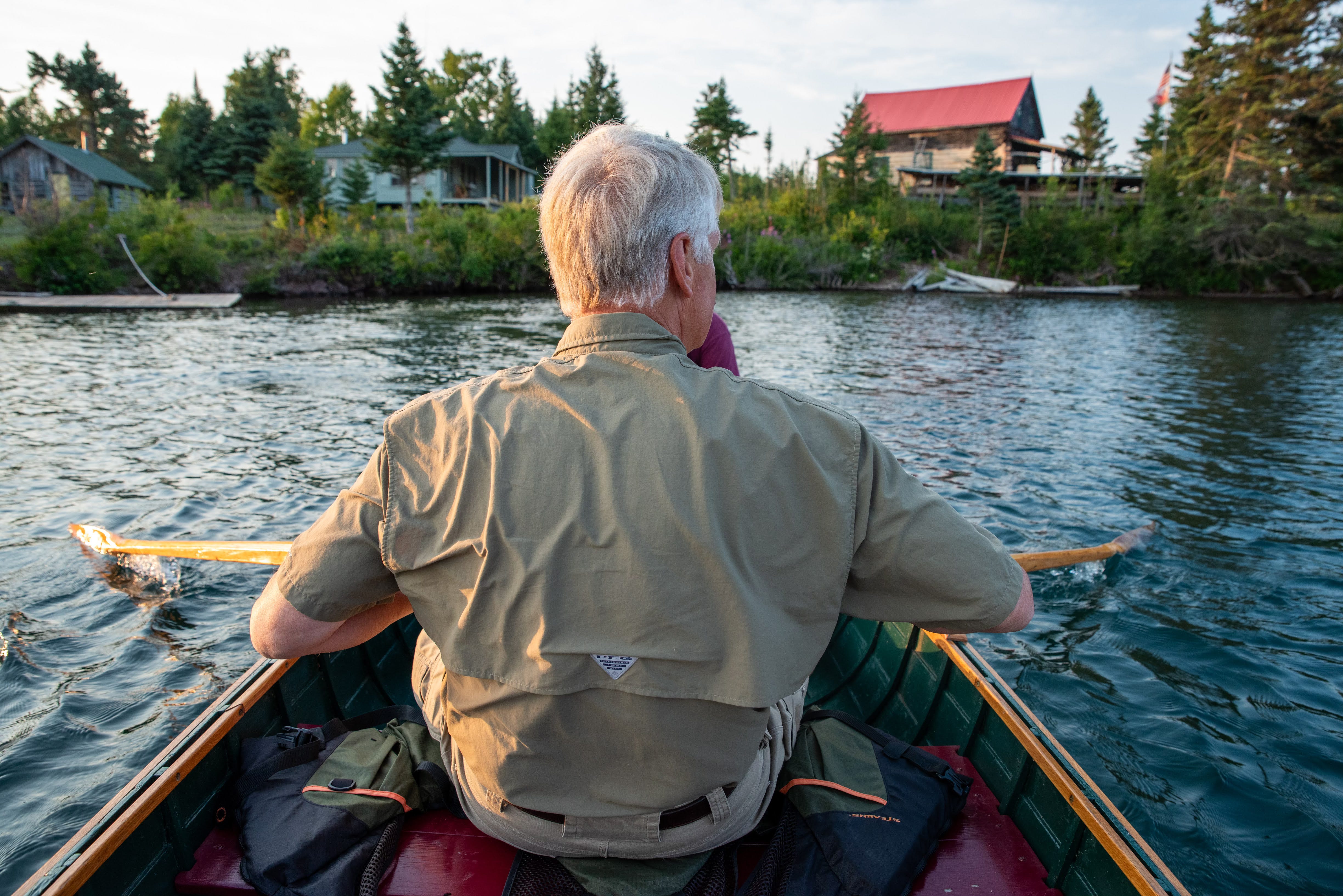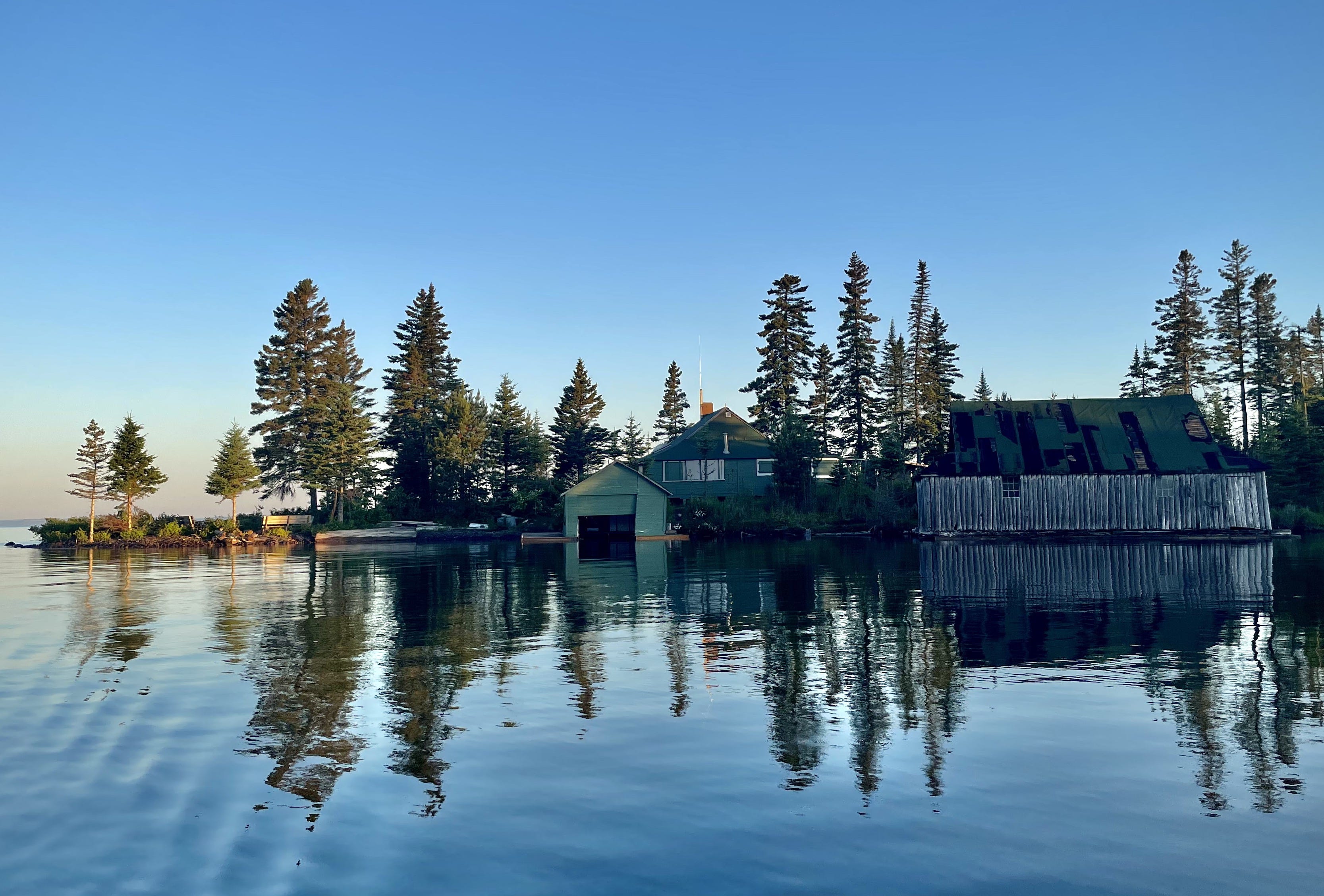At 5:00 a.m., my wake-up call comes—a low, throaty grunt I’ve come to recognize.
I step outside into the cool predawn light. No movement. No shadow. But he’s out there.
It looked like a perfect morning for a row, so I threw on a shirt and pants and headed toward the boat. Sometimes I take the canoe, sometimes the rowboat, depending on the mission. This morning’s mission was clear: venture out into the lake and size up the conditions. I needed to get the crew off the lighthouse that day, or risk them missing the ferry home the next morning. And they were ready, having spent two more days than necessary because the wind direction and velocity kept me from trying the hazardous dock. A full five days in the confines of the Rock of Ages Lighthouse is usually enough for anyone.
Halfway to the water, I glance back toward the Johns Hotel and there he is—his great palmate antlers rising above the brush, still as a carving, watching me work. By the time I’m sliding into the small harbor, he’s back to grazing.
When my family asks why I keep returning here for weeks at a time, he’s part of it. So are the mergansers shepherding their broods, the family of otters (seven at last count) that surface without warning, the loons with their eerie calls, the gull who berates me when the bread runs out, the peregrine falcon who doesn’t get along with the local eagle, and the evening fish that leap for insects. From the quiet of a small boat, where I’m no threat, the show never stops.

“It’s my nightmare,” my daughter says, imagining life without running water, electricity, flush toilets, or refrigeration. But for me, those absences are part of the attraction. They offer a taste of how the people who once lived here endured—and sometimes thrived—in this environment. Doing laundry in a bucket with a plunger isn’t exactly romantic, but it does build appreciation.
The history is another pull. My cabin once belonged to Florence Andrews, wife of Minneapolis grain trader A.C. Andrews, whose own cabin stood just a hundred feet away on the opposite shore of Barnum Island. At the turn of the 20th century, George Barnum and his wealthy friends built five cabins here. Families with long connections to the Barnums still maintain three. The fourth—the one I’m staying in—is maintained by the Rock of Ages Lighthouse Preservation Society. The fifth, sadly, has been left to decay; ironically, it was the original Barnum house.
The Barnum and Sivertson families are threads in a larger tapestry woven from fishing, tourism, and hard living in Washington Harbor. I’ll share more of those stories another time.
Here on the island’s far western end, the pace is unhurried. Most park visitors never make it this way. The busier Rock Harbor side has the lodge, restaurant, and bigger campgrounds. Windigo Ranger Station, in Washington Harbor, offers only a small store, a visitor center, and a modest campground. Between forty and a hundred people arrive each day, most on two small ferries from Grand Portage, Minnesota—one primarily serving day-trippers, the other campers and paddlers. Few venture farther west. An occasional boater might pass, but often it’s just us locals.
It’s the perfect place for reading, writing, and letting your body fall into the natural rhythm of the sun. Weather keeps things from getting too predictable, adding both challenge and variety—especially when the lake is your highway and you depend on its mood.
And for me, there’s another reason—memories. This was a regular stop in my family’s sailing days. Each visit draws those childhood moments to the surface and makes me wonder: what drew the first Indigenous travelers here? The fishermen? The summer families who endured the long, hard trip for a season of escape?
I’m still looking for those answers—and I’ll share them, the ones you won’t find in any park brochure, in the posts to come.


Comments
Post a Comment